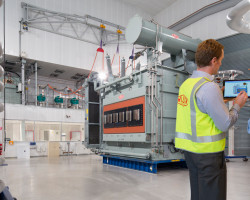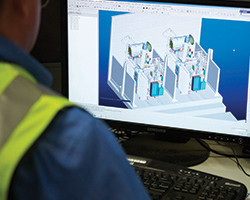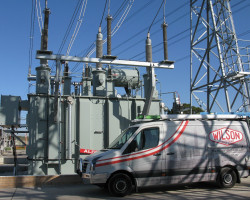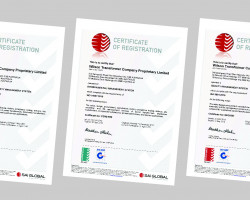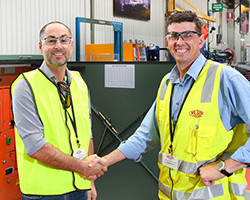Wilson Transformer Company have two world class manufacturing plants, producing power transformers up to 550MVA, 400kV and distribution transformers up to 5,000kVA, 72kV. Both facilities were recently upgraded with to increase capacity and capability utilising latest equipment and systems.
Power Transformers
Our power transformer manufacturing facility is divided into three major workshops: the electrical assembly operations, the mechanical welding and surface treatment painting operations, and the electrically isolated high voltage test laboratory.
1.Electrical Assembly
Core: Core steel rolls up to 1000mm wide are cut and automatically stacked using our GEORG cutting line. Dimensional accuracy of the cut sheets are verified to ± 0.01mm using an optical measuring table.
The automatically stacked legs are transferred to the core building area where the pallets of steel are ergonomically positioned using hydraulic tables to ensure that steel is not damaged during the stacking process.
Cores are stacked using machined guides to assure dimensional accuracy on tables that have a flatness tolerance of ± 1.0mm. Finished cores, excluding the top yoke, up to 90 Tonne capacity are raised to the vertical position via a hydraulic table.
Insulation & Winding: Insulation kits are manufactured in house using a CNC cutting machine, drills, and block punching machines. The winding cylinders and spacer block assemblies are all manufactured in house for just in time supply.
Windings are wound under tension using vertical and horizontal lathes on mechanically expanding mandrels. The winding area is segregated from other departments in a pressurised environment to minimise cross contamination of airborne particles.
The winding insulation structure is designed and constructed to principles proven by Lightning and Switching Impulse tests. Shielding, interstrand, partial and full interleaving techniques are used to control impulse voltages on higher voltage windings. Continuously transposed conductors are used where necessary to reduce eddy current losses in higher current windings. Pressboard spacers, sometimes assisted by oil flow washers, are used to maintain axial and radial cooling ducts.
Prior to assembly onto a core, windings are dried under vacuum and sized using isostatic pressing to assure their axial dimensions and capability to withstand short circuit forces.
Assembly, Dry-Out & Tanking: Sized windings are assembled onto a core in our customised assembly workstations that provide optimum safety in the workplace. The workstations minimise the risk of working at heights during the assembly of the active part of a transformer.
All active parts are Vapour Phase dried using Micafil plants to guarantee a moisture content of less than 0.5%. The dried core & coil assembly is then rapidly clamped, placed in their tank and the transformer vacuum oil filled. Sophisticated oil treatment and vacuum plants are used for filling transformers with mineral oils or natural ester fluids from our dedicated storage facility.
All transformers can be fully erected prior to test using best practice safety equipment such as man and boom lifts that eliminate the need to work from ladders. The electrical assembly workshop is capable of lifting transformers up to 220 Tonnes capacity while assembled units are moved from the tanking area to the high voltage test laboratory using air skates with a capacity of up to 300 Tonne.
2.Mechanical Welding & Surface Treatment
Tanks & Mechanical Components: Tanks are manufactured and tested to be leak free and capable of withstanding full vacuum and the required operating pressures. Submerged arc (laser track) welding machines are used for welding enabling long runs, excellent penetration, prevention of pin holes, and high mechanical strength. General welding is performed with automatic MIG welding machines which reduce spatter and increase weld quality. All welds used by Wilson Transformer Company have been tested to AS1554 to ensure best practice.
Tanks are provided with either welded or bolted lids and include appropriate hand hole inspection covers as specified by the customer or recommended by Wilson Transformer Company.
Surface Treatment: All tanks and mechanical components are cleaned to a purity of Sa 2.5 using chilled iron grit which consistently produces an angular profile of 50-70um to ensure paint adhesion. Our proven two or three coat paint systems with a zinc rich undercoat and an acrylic Polysiloxane top coat are applied to provide an external corrosion protection up to C4 or C5M ISO classification respectively.
Stainless steel pipes up to 80 mm diameter and stainless steel components are also used in areas such as feet for conservators and feet for separately mounted radiator banks.
3.High Voltage Test Laboratory
All power transformers undergo a comprehensive regime of routine tests and appropriate type tests in accordance with the customer’s requirements, the appropriate national and international standards and Company procedures. Customers are welcome to witness testing.
Our high voltage test laboratory is fully shielded, acoustically treated and electrically isolated. The background noise for partial discharge testing is < 10pC and <35dB A for sound level testing.
Test equipment includes Haefely Impulse Generators to 1600kV 160kJ, Haefely 500kV AC test system, Haefely 100kV/4000A loss measurement systems and Power Diagnostic Partial Discharge measurement systems. All test equipment is calibrated in accordance with international standards.
Distribution Transformers
Our distribution transformer manufacturing facility is divided into four major workshops: the electrical bay operations, the fabrication workshop operations, the surface treatment operations, and the final assembly and testing operations. The facility also incorporates extensive storage capability for finished products.
1. Electrical Bay Operations
Cores: Distribution transformer cores are of non-circular step-lap construction. The smaller cores are made using AEM “wound” core equipment, while the larger cores are made with high speed Georg cut-to-length notch and mitre equipment with automatic precision lamination stacking.
Windings: Winding machines include Tuboly and other high quality equipment. LV windings predominantly have single sheet conductor and strip conductor for the small pole mount transformers. HV windings use full width or tapered layer insulation with round or rectangular conductor. HV winding machines incorporate dynamic tension control and conductor flattening to achieve a high space factor and quality windings. Aluminium or copper conductors are used to optimise cost and losses. Insulation throughout is double-sided diamond dot coated. This arrangement, when cured and combined with a suitable clamping structure, results in a very strong, short-circuit proof distribution transformer.
2.Fabrication Workshop Operations
A range of computer controlled cutting, punching and folding machines, including a fin-folding line for processing steel for transformers and package substations. The processed steel is welded or prepared as required. Some external capacity is used to augment these activities.
3.Surface Treatment Operations
Three proven systems are provided:
- Galvanising - Pole mount distribution transformer tanks up to 500kVA and other applications such as substation base and bolt on radiators
- Grit blast, zinc rich prime and polyester powder - Generally distribution transformers above 500kVA
- Grit blast, zinc rich prime and an acrylic polysiloxane top coat - For transformers subjected to an extremely aggressive environment.
Package substation enclosures include high performance substraights such as marine grade aluminium and 3CR12 stainless steel finished with a proven paint system.
4.Assembly and Test Operations
Transformer Assembly, Dry-out, Tanking and Processing: Software controlled drying systems using low frequency power under vacuum optimise the dryness of windings and assembly insulation. A computer controlled autoclave with convection heating and vacuum ensures the dryness of larger units. The dry core and coil assembly is integrated into a fin-cooled or in some cases a radiator cooled tank in the most economical manner to provide appropriate interface connections to the customer’s system.
High quality oil, which has been filtered, de-gassed and the moisture level reduced to less than 5ppm, is then introduced into the transformer under vacuum.
Our design philosophy for distribution transformers is to seal the transformer from the external environment to prevent the entry of moisture and air. Extensive development testing has determined the acceptable safe pressure in transformer tanks under full load and overload conditions.
Substation Assembly: Package substation also known as kiosk substations and compact MV substations are important products for us. Extensive product development and the use of flow production techniques contribute to a quality outcome in the assembly of a transformer, base, enclosure and LV and HV switchgear in package packages.
Test: Three state of the art electrical test facilities confirm the performance of our products before delivery to customers. All transformers are subjected to comprehensive routine tests and specified type tests, in accordance with the customer’s requirements, relevant standards and Company procedures. All high voltage tests are performed in test facilities that are isolated from the main assembly bays.
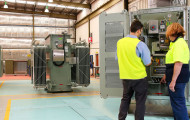 Products Overview
Products Overview
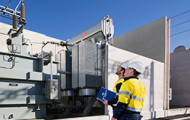 Power Transformers (≤550MVA)
Power Transformers (≤550MVA)
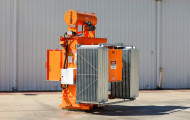 Distribution Transformers (≤5,000kVA)
Distribution Transformers (≤5,000kVA)
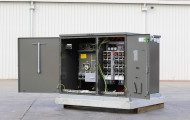 Compact MV Substations
Compact MV Substations
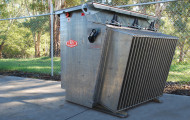 Special Applications
Special Applications
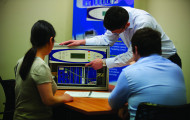 Monitoring & Control Solutions
Monitoring & Control Solutions
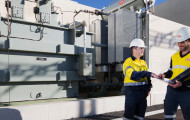 Service And Support Overview
Service And Support Overview
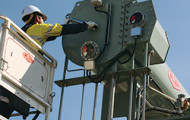 Site Installation and Testing
Site Installation and Testing
 Transformer Assessment
Transformer Assessment
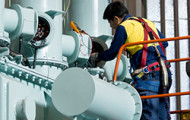 Upgrade, Repair and Refurbishment
Upgrade, Repair and Refurbishment
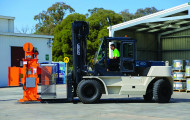 Storage & Consignment
Storage & Consignment
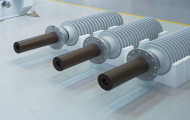 Spare Parts
Spare Parts
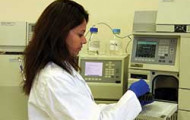 Oil Sampling, Analysis & Diagnostics
Oil Sampling, Analysis & Diagnostics
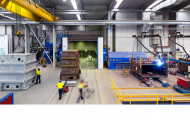 World Class Capabilities Overview
World Class Capabilities Overview
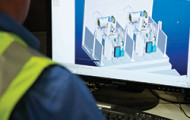 Design
Design
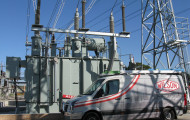 Services and Support
Services and Support
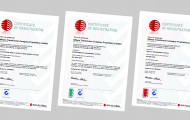 Standards & Compliance
Standards & Compliance
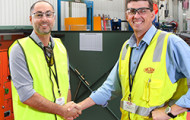 Supply Chain Management
Supply Chain Management
 Generation
Generation
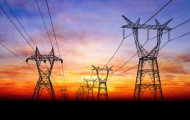 Transmission
Transmission
 Distribution
Distribution
 Infrastructure
Infrastructure
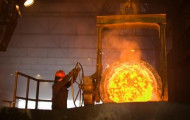 Industrial
Industrial
 Oil & Gas
Oil & Gas
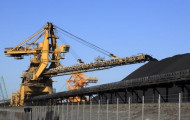 Mining
Mining

